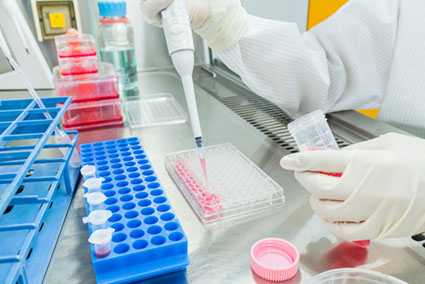CRISPR-based diagnostic methods
Overview
Many CRISPR enzymes can be useful in biomedical applications to recognize biomarkers of infectious and non-infectious diseases (viruses, bacteria, etc.), as well as cancer and many other diseases that in some way involve a nucleic acid sequence (either RNA or DNA).
Collateral cleavage for identification using CRISPR
CRISPR systems are usually used for genome editing, but they can also be used in applications that have no genome editing component. One of the more recent applications of CRISPR is in identification of pathogens causing infectious diseases, using enzymes in the Cas9, Cas12, Cas13, and Cas14 families, many of which are still in the research phase.
Cas9 methods for pathogen identification can be divided into those that use enzymatically active Cas9 [1]and those that use catalytically inactive (dead) Cas9, known as dCas9 [2, 3]. All the Cas9-based methods of pathogen identification can theoretically identify any DNA sequence having a Cas9 target site and PAM sequence. Another way Cas9 can be used in recognition of the disease-causing microorganisms is by cleavage of a pathogen’s genomic DNA into pieces sized appropriately for next generation sequencing [4].
dCas9-based systems
The “PC” (which stands for “paired dCas9”) reporter system is an example of a system using dCas9. This technique consists of 2 molecules of dCas9 each connected to a half-molecule of firefly luciferase. When both dCas9 molecules are directed by guide RNA (gRNA) to pre-specified DNA sequences near each other in the genome of the pathogen of interest, the 2 halves of the luciferase come together, and light is emitted [2]. The PC reporter system is extremely sensitive, finding as little as 1 molecule of DNA [5] and was shown to identify the DNA sequence for tuberculosis [2] and likely any DNA sequence, as long as there are 2 good target sequences at an appropriate distance from each other.
Cas12, Cas13, and Cas14 methods
There are several Cas12, Cas13, and Cas14 enzymes. Identification methods have been developed using several of these enzymes, including Cas12a, Cas12b, Cas13a, Cas13b, Cas13d, and Cas14a from a wide variety of bacterial species. Some of these techniques use several of these enzymes simultaneously, allowing multiplexing assays for the purpose of distinguishing pathogens.
Collateral cleavage
The Cas12-, Cas13-, and Cas14-based techniques depend on a process known as collateral cleavage. That is, when one of these enzymes binds its target as directed by gRNA, the enzyme cleaves not only the target but also other nucleic acids nearby in the solution.
Cutting by a CRISPR enzyme is often not perfect and can result in cleavage of other things. Cas12-, Cas13-, and Cas14-based methods are rapidly growing in popularity and these technologies depend on collateral cleavage (also called “trans cleavage”), a process in which Cas enzymes cut not only the target DNA or RNA but also a large number of unrelated DNA or RNA molecules nearby in solution. Because labeled RNA or DNA can be added to the assay, this process allows for significant signal amplification [6, 7].
Isothermal amplification
The SHERLOCK (Specific High-sensitivity Enzymatic Reporter unLOCKing) technique has been developed for identification of RNA sequences, and DETECTR (DNA endonuclease-targeted CRISPR trans reporter) for DNA detection [7]. Both SHERLOCK and DETECTR require isothermal amplification of the target sequence before the CRISPR cleavage step to obtain sufficient quantities of relevant sequences for identification. In SHERLOCK, the isothermal amplification step is followed by T7 transcription to generate RNA. In DETECTR, T7 transcription is not performed, as DNA is targeted instead of RNA. Standard DETECTR uses LbCas12a, which requires a PAM site, whereas SHERLOCK uses 1 or more Cas13 enzymes and other enzymes, removing the requirement for a PAM site [6]. There is also a modification of DETECTR that uses Cas14a, which too removes the need for a PAM site [8]. DETECTR has been shown to differentiate between 2 forms of human papilloma virus (HPV) [7]. SHERLOCK has been shown to identify Zika and dengue viruses, and to identify different mutations in liquid biopsies from non-small cell lung cancer patients [6].
Explore resources
IDT webinar
References
- Pardee K, Green AA, Takahashi MK, et al. Rapid, Low-Cost Detection of Zika Virus Using Programmable Biomolecular Components. Cell. 2016;165(5):1255-1266.
- Zhang Y, Qian L, Wei W, et al. Paired Design of dCas9 as a Systematic Platform for the Detection of Featured Nucleic Acid Sequences in Pathogenic Strains. ACS Synth Biol. 2017;6(2):211-216.
- Guk K, Keem JO, Hwang SG, et al. A facile, rapid and sensitive detection of MRSA using a CRISPR-mediated DNA FISH method, antibody-like dCas9/sgRNA complex. Biosens Bioelectron. 2017;95:67-71.
- Li J, Wang Y, Wang B, et al. Application of CRISPR/Cas Systems in the Nucleic Acid Detection of Infectious Diseases. Diagnostics (Basel). 2022;12(10):2455.
- Li Y, Li S, Wang J, Liu G. CRISPR/Cas Systems towards Next-Generation Biosensing. Trends Biotechnol. 2019;37(7):730-743.
- Gootenberg JS, Abudayyeh OO, Kellner MJ, et al. Multiplexed and portable nucleic acid detection platform with Cas13, Cas12a, and Csm6. Science. 2018;360(6387):439-444.
- Chen JS, Ma E, Harrington LB, et al. CRISPR-Cas12a target binding unleashes indiscriminate single-stranded DNase activity [published correction appears in Science. 2021 Feb 19;371(6531):]. Science. 2018;360(6387):436-439.
- Harrington LB, Burstein D, Chen JS, et al. Programmed DNA destruction by miniature CRISPR-Cas14 enzymes. Science. 2018;362(6416):839-842.
RUO22-1445_001
